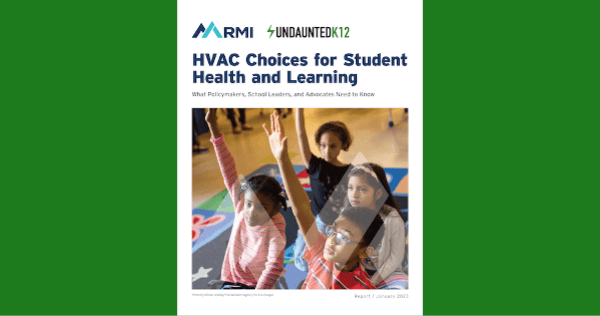RMI and UndauntedK12 Report: HVAC Choices for Student Health and Learning


The report (which credits enVerid CEO Christian Weeks for his insights and links to the recent white paper, How to Achieve Sustainable Indoor Air Quality) first lays out the evidence of the deplorable condition of school HVAC systems across the country, with particular emphasis on those who suffer disproportionately: “students of color, low-income students, and rural students who are more likely to attend school in buildings suffering from chronic underinvestment.” Student health and learning is linked to temperature, humidity, and indoor air quality “with over 70% of K-12 school floor space nationwide using on-site fossil fuel combustion for heating,” which makes school HVAC systems “significant sources of pollution in the community.” In fact, the report states, “young children are physiologically more susceptible to health impacts from exposure to poor indoor air quality.”
The solution, according to the report, is to modernize and electrify school HVAC systems, with high-performance all-electric heat pumps offering both efficient heating and cooling without producing any on-site emissions. The report emphasizes the point that “given that schools regularly operate HVAC systems for 30 years or more, all new HVAC equipment installed today must be all electric to comply with our national goal of achieving net-zero emissions by 2050.” By making the switch from fossil fuels and improving air quality, the report predicts a reduction in school absenteeism as “asthma is a leading cause of absenteeism, resulting in some 13.8 million missed school days annually.” Other benefits for schools include safety from gas leaks and CO and a reduction in smog and the negative health effects of combustion pollution. In addition, the report states that heat pumps are quieter than legacy systems and are likely to better control indoor environmental quality (temperature, humidity, and air quality), leading to improved learning outcomes.
As part of these upgrades, the report recommends that conditioning, ventilation, and filtration are all addressed, creating a reliable, efficient, healthy system that complies with regulations. In addition to discussing technologies such as air-source heat pumps, the report touches on ground-source heat pumps, variable refrigerant flow, solar thermal water heating, heat recovery chillers, high-performance filtration, dedicated outdoor air systems, air-side economizers, demand control ventilation, energy recovery ventilation, and variable air volume. In discussing ventilation, the report points out that sorbent filters may be “used to remove harmful gases like volatile organic compounds” from indoor air (which can reduce the need from outside ventilation and improve overall HVAC system efficiency without compromising IAQ). Of course, we would recommend enVerid Sorbent Ventilation Technology® as an extremely energy-efficient indoor air quality improvement approach in schools. The report encourages making complex HVAC system decisions within a full context including, for example, a review of building orientation, climate, and the building envelope. A sample approach included in the report is shown below.

When one considers that HVAC systems account for 56% of energy used in K-12 schools nationally, the need to prioritize these upgrades becomes even more urgent to reduce energy use, cost, and emissions. The report addresses cost concerns with a process for evaluating HVAC upgrade costs and opportunities for funding, including tax credits included in the Inflation Reduction Act, utility incentives, and offerings through the Department of Energy, the EPA, and the Department of Education. Finally, recognizing that these decisions rely on a complex web of stakeholders, the report offers specific recommendations for policymakers, school leaders, parents and teachers, designers, and researchers and funders.
Learn more about SVT® in Green Schools here.

Doug Engel
Doug Engel is SVP Sales and Marketing, enVerid Systems
Subscribe to our blog


